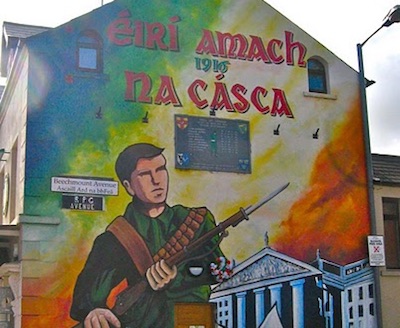
This article was published in Republican News in the 1973 Easter Commemoration issue (21st April). This may be a reprint from an earlier publication (possibly Wolfe Tone Monthly). The language, such as ‘Irish Ireland’ suggests a date in the 1930s or 1940s. Some of the detail may also be inaccurate. Enough of those who mobilized in Belfast in 1916 were Protestant, like Sam Heron himself and Herbert Pim, that the idea of a march to an anniversary mass in 1917 reads more like a vision of 1917 seen through the prism of the conservatism of the 1930s.
According to Roger McCorley, in a memoir, in the aftermath of the 1916 Rising and the releases from Frongoch that autumn, the Sinn Féin movement was re-organised in Belfast in early 1917 and the Sean McDermot branch of the Irish Volunteers was re-established in February/March 1917. This was followed in May by the formal re-structuring of the units in the city (including, for a time, a political commissar). As Easter was on 8th April, the 1917 Easter Rising commemoration took place between these two events. (From the Treason Felony)
Belfast Easter Commemoration, 1917
Easter Sunday 1917 dawned bright and clear over the Falls Road, Belfast. In the Irish Ireland Club which stood on the site of what is now Barrack Street School, the Irish Volunteers made last minute plans for the first Easter Commemoration Parade to honour those comrades who had given their lives in the Rising of the previous Easter.
The Irish Volunteers had been formed at an inaugural meeting on 25th November, 1913 in Dublin at a meeting chaired by Eoin McNeill. They were re-organised in the North after the Rising.
The enrollment form of the Irish Volunteers put forth the objectives clearly:-
“I the undersigned, desire to be enrolled in the Irish Volunteers founded to secure and maintain the rights and liberties common to all the people of Ireland without distinction of creed, class or politics.”
Easter Sunday 1917 evoked bitter-sweet memories of the Glorious stand in Dublin. The Volunteers from Belfast had assembled at Coalisland on Easter Monday 1916 and had formed a junction with Volunteers from Tyrone and other areas. Now, the leaders Pearse, Connolly, Clarke, McDonagh, Plunkett, Ceannt and MacDiarmada were all dead, and other leading Republicans had also been summarily executed. Two of these leaders had associations with Belfast. James Connolly organiser of the Irish Transport and General Workers Union had lived at 420 Falls Road from 1910 to 1913. Sean MacDiarmada, a native of Leitrim, lived in Butler Street, Ardoyne, prior to 1916. He was employed as a tram driver with Belfast Corporation.
Republicanism in the North was at a low ebb, and whilst the citizens of Dublin made a show of strength in their new found aspirations to Liberty by hoisting the Tricolour over the G.P.O. the ripples on the pool barely reached Belfast. Belfast was a long way from Dublin in 1917.
It was in these circumstances that Sam Herron mustered his party of about 150 men in Divis Street. At 11 o’clock the order rang out and the gallant band of Irish Volunteers which included Mick Carlin, Cathal Bradley, Senior, Pat Nash and Sean Malone, started out on the march to Clonard Monastery for an Anniversary Mass, which was to be celebrated at Noon.
The March proceeded peacefully enough along the Falls Road. It is recorded that the people came to gaze with something akin to astonishment at this small party of men who dares to challenge the might of the British Empire, by proclaiming openly their allegiance to their beloved Irish Republic. No women took part in this match, no bands played, no emblems were worn, no banners were carried, save at the head of this gallant company, a lightening breeze rippled the folds of the National Flag.
The march is over, the Mass is said, and the men dispersed. All appears to be the same on the Falls Road, yet it is not – unseen the men on the 1917 Easter Commemoration March had sown the seeds of Freedom as they went along, soon the Tree of Liberty would put forth a profusion of blossoms.
The British Occupation Forces recognized the danger – and a few days later nearly all those who had taken part were arrested. The people of Belfast made no protests at the arrests and the following year the Falls Road was bedecked with Union Jacks to welcome home the troops from the 1914/18 War. Belfast was not yet ready...
Who will measure the passionate bravery which impelled the men on the 1917 march to seek to attain what seemed to many the unattainable Freedom. Who will measure the passionate bravery of those who gave their lives in the Rising, and whose blood sweetened the arid ground where it fell. Liberty might well hide her head and blush at the gifts her Irish Patriot Sons have showered on Her.
By Sarah Murphy
![[Irish Republican News]](https://republican-news.org/graphics/title_gifs/rn.gif)
![[Irish Republican News]](https://republican-news.org/graphics/title_gifs/harp.gif)

